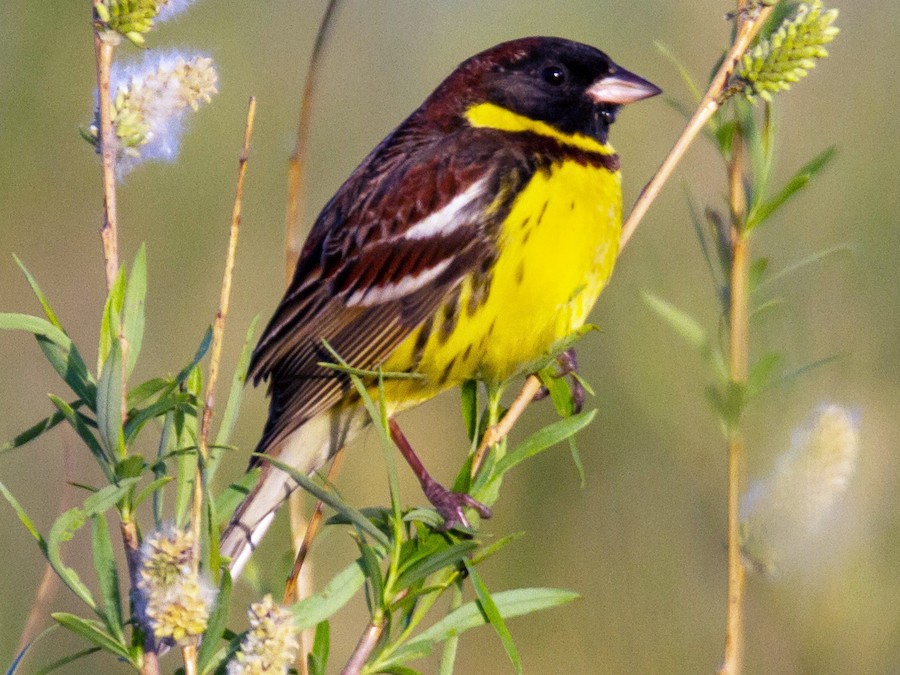
Yellow-breasted Bunting
Emberiza aureola
Order:
Family:
Size:
15-16 centimeters
Weight:
16-22 grams
Taxonomy:
Pallas, 1773
Short Description:
The yellow-breasted bunting (Emberiza aureola) is a Eurasian passerine bird in the bunting family (Emberizidae). The genus name Emberiza is from Old German Embritz, a bunting. The specific aureola is Latin for "golden". The bird's call is a distinctive zick, and the song is a clear tru-tru, tri-tri. Until 2004, the International Union for the Conservation of Nature considered the yellow-breasted bunting to be a species of least concern. Since 2004, it has been gradually upgraded to a status of Critically Endangered due to rapid drops in population sizes. It is subject to heavy hunting pressure in China, through which most specimens pass during migration. The yellow-breasted bunting is a small passerine, ranging from 14 to 16 cm (5.5 to 6.3 in) in length, and weighing 17 to 26 g (0.6 to 0.9 oz). For a bunting, it is large and rather stocky. The breeding male has bright yellow underparts with black flank streaks, brown upperparts, black face and throat bar, and a pink lower mandible. The female has a heavily streaked grey-brown back, and less intensely yellow underparts. She has a whitish face with dark crown, eye and cheek stripes. The juvenile is similar, but the background colour of the underparts and face is buff. It breeds in north-eastern Europe and across northern Asia. It is migratory, wintering in south-east Asia, India, and southern China. It is a rare but regular wanderer to western Europe. There are also ~4 records from the Aleutian Islands of Alaska and a 2017 record from Labrador, Canada. The species winters in large flocks in cultivated areas, rice fields and grasslands, preferring to roost in rice-fields. Populations have declined precipitously since the early 2000s, and the species is now considered to be critically endangered. The decline of the yellow-breasted bunting is likely to be caused by substantial trapping during migration and most specifically at winter sites. Birds are flushed then caught in mist-nets, to be sold for consumption as "sparrows" or "rice birds". Even though the actions have been restricted to a small area in southern China, it has become more widespread and popular to increasing wealth, and hunters now travel long distances to find sufficient birds. Shifts in rice paddy irrigation practices have reduced the quality and quantity of wintering habitats, including the loss of water stubble, and the loss of reedbeds has reduced available roost sites. In Pakistan, Yellow Breasted Bunting is a vagrant, with only two records (Gawadar/Makran and Marala/Sialkot).
Far far away, behind the word mountains, far from the countries Vokalia and Consonantia, there live the blind texts. Separated they live in Bookmarksgrove right at the coast
The Yellow-breasted Bunting is primarily found in the northern and northwestern regions, including Punjab, Khyber Pakhtunkhwa, and parts of Gilgit-Baltistan. It inhabits grasslands, farmlands, and marshy areas.
Yellow-breasted Buntings are migratory birds, spending summers in breeding grounds across Eurasia and wintering in South Asia, including Pakistan. They forage on seeds, insects, and grains, often feeding on the ground or in low vegetation. Breeding pairs build cup-shaped nests in dense vegetation, and males sing to establish territories and attract mates during the breeding season. However, their populations have declined significantly due to habitat loss and illegal trapping for the pet trade. Conservation efforts are crucial to protect this species in Pakistan and throughout its range.
Far far away, behind the word mountains, far from the countries Vokalia and Consonantia, there live the blind texts. Separated they live in Bookmarksgrove right at the coast
About Photographer : Hello World
Facebook
Twitter
Instagram
Flicker
LinkedIn

